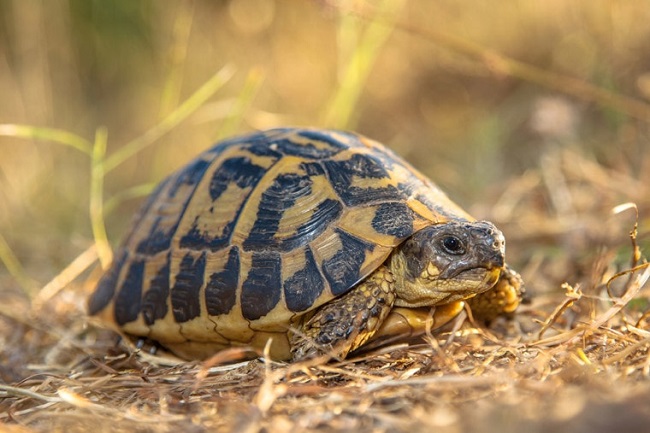Turtles are captivating creatures that carry their homes on their backs, symbolizing resilience and longevity. While they might not be your conventional furry friend, land turtles can make interesting and rewarding pets.
However, each turtle species has distinct needs and lifestyles that potential owners should be aware of. Let’s dive in to discover the eight types of land turtle species that make great pets!

8 Types of Pet Land Turtles Species
Here is a list of 8 Types of Pet Land Turtles Species:
Read Also:
1. Russian Tortoise
The Russian tortoise, also known as the Horsfield’s tortoise, is a small species, typically reaching lengths of only 8 to 10 inches. They have a broad distribution, ranging from Iran to China, and are accustomed to arid environments.
They have a strong build, a blunt head, and four toes on each foot, which are characteristic traits of the species. In captivity, they eat a diet mainly composed of leafy greens and require a dry substrate to live on.
2. Greek Tortoise
Greek tortoises, also known as the spur-thighed tortoises, come from the Mediterranean. They are distinguished by the spurs on their thighs and the highly variable coloration and pattern on their shell.
They thrive in various habitats, including coastal dunes, scrublands, and meadows. Greek tortoises require a balanced diet of vegetables, fruits, and grasses, and a secure outdoor enclosure is ideal for their housing.
3. Hermann’s Tortoise
Hermann’s tortoises are native to the Mediterranean and are named after French naturalist Johann Hermann. They possess a distinctive carapace that’s oblong and domed, with a bright pattern of yellow and brown, and their tail ends in a horny tip. Hermann’s tortoises are herbivorous and need a diet rich in fiber and calcium.
4. Marginated Tortoise
Marginated tortoises are the largest of the European tortoises, native to Greece, Sardinia, and the Balkans. Their name comes from the distinctive flared ‘margins’ on the back of their shell. They thrive in cooler temperatures and prefer a herbivorous diet of greens, vegetables, and fruits.
5. Sulcata Tortoise
The Sulcata, or African spurred tortoise, is the third-largest species of tortoise in the world and the largest species of mainland tortoise. They are native to the Sahara Desert and the Sahel, a transitional eco-zone separating the Sahara from the Sudanian Savanna.
Sulcatas are robust and can adapt to various climates but thrive best in hot and arid conditions. They are known for digging burrows and need a spacious outdoor enclosure.
6. Red-Footed Tortoise
Red-footed tortoises are native to South America and are known for their distinctive red or orange patches on their legs.
They are omnivorous, with a diet consisting of a mix of plants and meat, including fruits, flowers, fungi, invertebrates, and carrion.
Red-footed tortoises have a social structure and are known to stack on top of each other in a dominance display.
7. Indian Star Tortoise
The Indian Star tortoise is native to dry areas and scrub forests in India and Sri Lanka. This tortoise species is well-known for the star-like patterns on its shell, with radiating streaks of yellow or tan on a black or dark brown background.
They are herbivores, feeding primarily on grasses, fallen fruit, flowers, and the pads of succulent plants.
8. Leopard Tortoise
Leopard tortoises are native to the savannas of eastern and southern Africa. They are one of the largest tortoises in the world, reaching sizes of over 18 inches in shell length. They are named for the leopard-like spotting on their shells. Leopard tortoises are grazing herbivores, feeding primarily on grasses, succulents, and thistles.
Read Also:
Conclusion
Turtles are unique creatures, each species possessing its own distinct traits, dietary needs, and care requirements.
Owning a land turtle is a commitment, but the rewards are immeasurable as these slow and steady companions offer a unique and engaging pet experience.
As you get to know your pet turtle, you’ll discover a captivating world of interactions that go well beyond the shell.
























